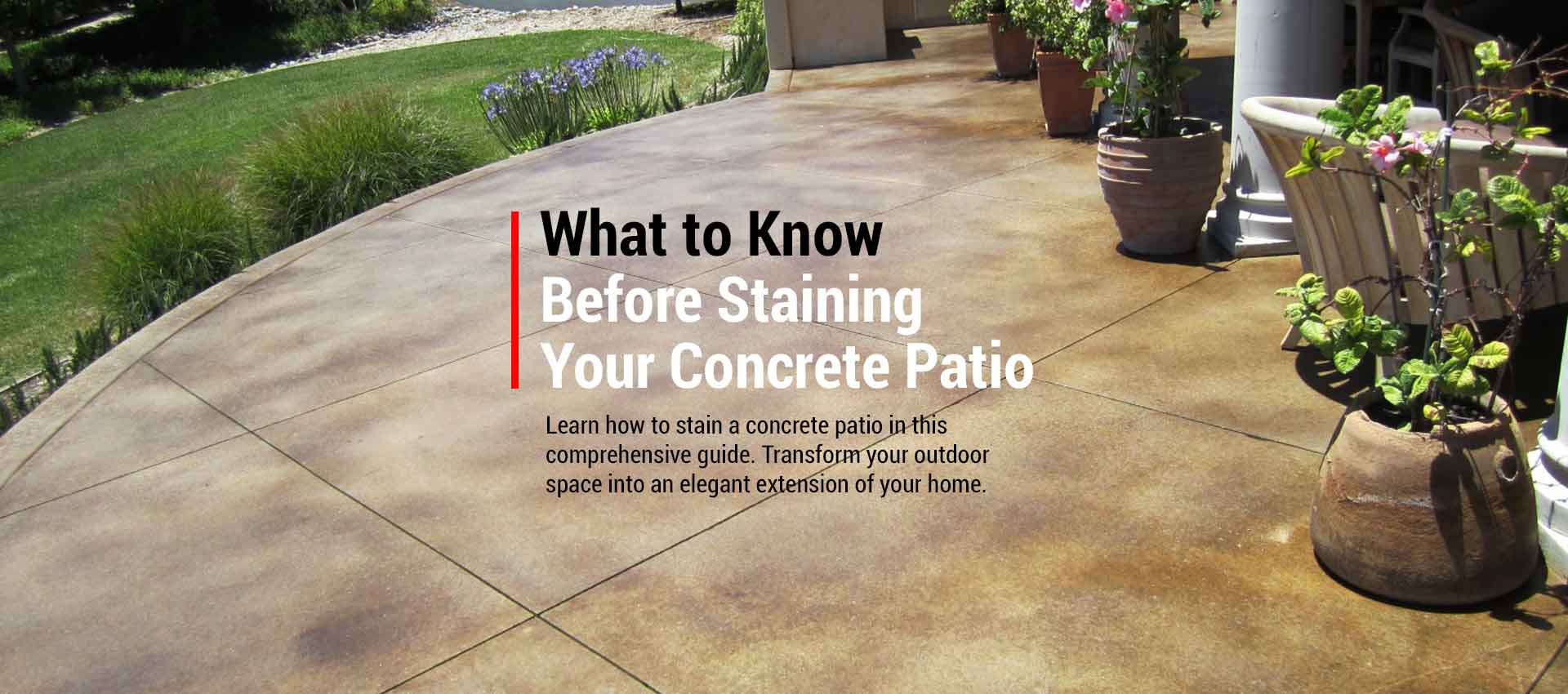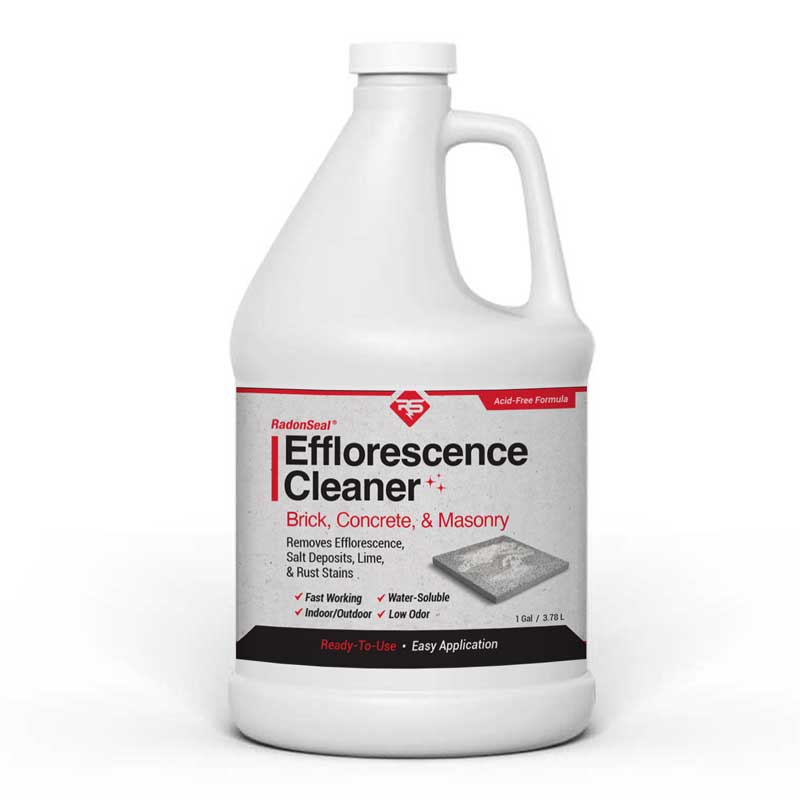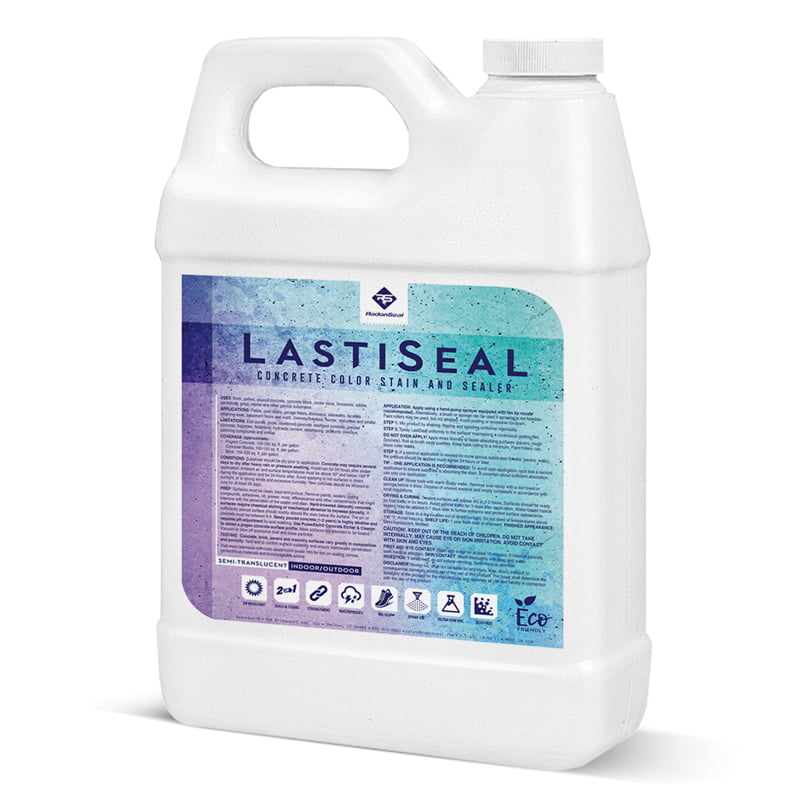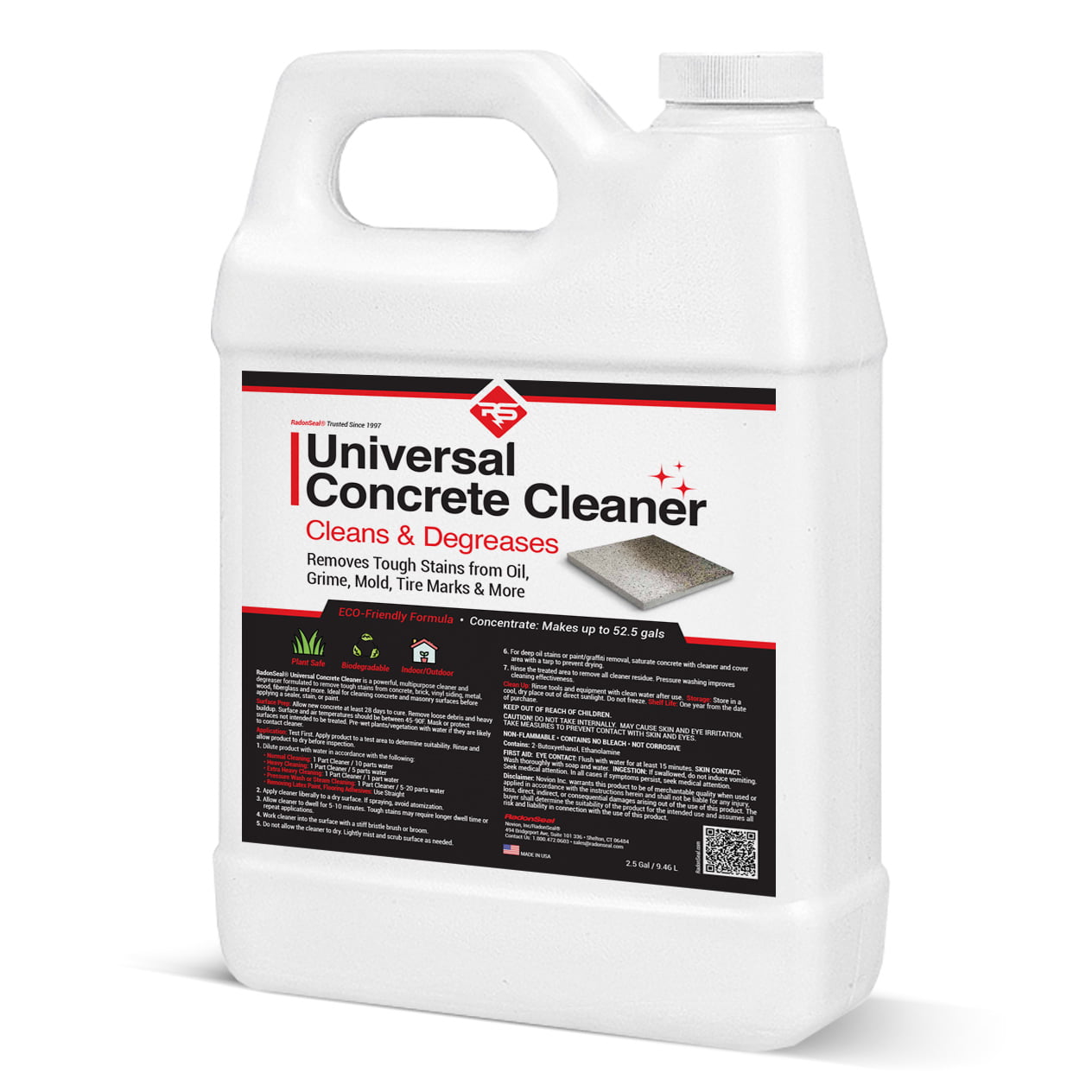Do-It-Yourself Guide to Staining a Concrete Patio
Looking to add color and style to your patio?
Applying a stain to your concrete, paver, or brick patio is a great way to do it! This easy and affordable DIY project can transform your drab patio into a beautiful extension of your home. In this article, we’ll explain how to stain a concrete patio like a pro, step-by-step. This article will cover the different types of concrete stains available, the tools and materials you’ll need, and provide some tips on how to keep your stained patio looking its best for years to come. So whether you’re a seasoned do-it-yourselfer or new to home improvement, read on for everything you need to know about staining your concrete patio.
Types of Concrete Stains
Before you pull out your sprayer, rollers, and brushes, you’ll need to know what types of stains are available for your patio staining project. Concrete stains come in four main types:
Topical Concrete Stains
Topical or film-forming stains are a very common and inexpensive way to add color to your paver and concrete surfaces. Topical concrete stains work by forming a thin, colored, coating on the surface of the concrete. They contain rather large acrylic stain particles suspended in a carrier, water, or solvent. After application, the carrier evaporates and leaves behind a colored acrylic shell.
When applied correctly, topical stains tend to produce a fairly uniform color. Color options for topical stains are plentiful. While the initial cost may be attractive, be aware that acrylic stains, like acrylic sealers (wet look / high gloss), will need to be reapplied every 1-2 years. Reapplication means stripping and removing the old product completely first! – there is no way to properly “touch up” faded or scratched areas.
Penetrating Concrete Stains
Penetrating stains work differently than topical stains. As the name implies, penetrating stains soak in below the surfaces and provide color without a film or coating on the surface. Penetrating stains use very small pigment “beads”, suspended in water or a solvent, that deposit themselves inside the pores. Very porous surfaces will absorb more color, while areas with lower porosity tend to absorb less. Because of this, penetrating stains generally produce varying levels of color intensity and an attractive mottled look.
Penetrating concrete stains provided almost unlimited color options. Penetrating stains can be applied not only to concrete, but to any porous masonry including bricks, blocks, pavers, or cultured stone. It is important to note that penetrating stains require a surface sealer to hold the pigment in the concrete. This adds significantly to the project cost and time. Most penetrating stain manufacturers recommend using an acrylic sealer over their stains. Acrylic sealers are the worst when it comes to protection – giving you roughly a year of service before reapplication is needed.
Concrete Acid Stains
Acid stains typically consist of a blend of water, hydrochloric acid, and acid-soluble metallic salts. Acid-based stains work by reacting with the naturally occurring hydrated lime, or calcium hydroxide, present in concrete. As the acid gently etches the surface, it facilitates the penetration of metallic salts. Acid stains produce varying color patterns and color intensities. Color options are limited – mostly earth tones, browns, and tans.
Applying an acid stain is somewhat of an unforgiving task. If you are not happy with the result, the only recourse is to grind your floor down and start over. An acid-stained concrete surface is only as good as the protective sealer you use on top of it. Without a sealer, the acid-stained surface will soon fade and wear away. Acid stains will cost roughly $0.40 – $0.80 per sq.ft. That does not include the required sealer, which can double your cost, making concrete acid stains the most expensive option.
Penetrating Stain & Sealer Combos
Concrete stain and sealer combination products are a great choice for homeowners who want to add color and protect their concrete surfaces. These products combine the benefits of a penetrating stain, which adds color and depth, and a penetrating sealer, which protects the concrete from deterioration, fading, and wear for many years.
There are several advantages to using penetrating concrete stain and sealer combination products. First, they are easy to apply. You can typically apply them with a sprayer, roller, or brush. Second, these products are more durable than traditional topical stain and sealers. They can withstand more foot traffic and exposure to the elements, so they are a good choice for high-traffic areas or outdoor surfaces. Finally, concrete stain and sealer combination products are more cost-effective than buying two separate products. You can get the color and protection you need in one easy-to-apply product.
The Best Way to Stain Your Patio
If you are looking for a way to add color and protect your patio, a penetrating concrete stain, and sealer combination product is the best option. The very best stain and sealer combo is LastiSeal Concrete Stain & Sealer. This product combines our industry-leading LastiSeal penetrating polyester and polyurethane sealer (with a 15-year service life) with organic stain beads that soak deep below the surface. Not only will you get a deep vibrant color, but you also get a premier sealer that holds the color in, while simultaneously protecting the surfaces from water, salt, molds, and deterioration.
Additional benefits of using LastiSeal Stain & Sealer include:
- Protection from surface wear & tear. LastiSeal cures as a hard polymer that strengthens and binds concrete, brick, & pavers. Harder surfaces hold color longer and are less susceptible to fading and scuffing.
- Unlimited color options. Choose from 38 standard colors or mix different colors to come up with something unique.
- Non-slip finish. Treated surfaces are not slippery when wet, as both the stain and sealer penetrate below the surface.
- Safe for indoor or outdoor use. LastiSeal Stain & Sealer is a water-based stain & sealer – people, plant, & pet safe, non-toxic, non-flammable, and has no odor.
- No additional sealer is needed. Save time and money by staining and sealing in one step. Our deep penetrating sealer locks in the stain to extend the life of the color.
If you are considering staining your patio, concrete floor, or garage floor, we recommend using a penetrating concrete stain and sealer combination product. You get the best of both worlds: beautiful color and long-lasting protection.
How to Choose the Best Concrete Stain for Your Patio
If you want your stained concrete floors to look their best, you need to choose your stain wisely. When choosing a concrete stain for your project, there are several factors you need to consider, such as location, the type of surface, the desired color, and the amount of traffic your patio, driveway, or walkways will receive.
Type of Patio: Picking the best concrete stain for your patio starts with identifying what type of patio you have – pavers, brick & mortar, concrete, stamped concrete, etc. The patio type may limit the type of sealer you can use. For example, acid stains can only be applied to concrete – they will not work on clay brick or pavers. Penetrating stains can be applied to any porous concrete or masonry, but many dense natural stones are not porous enough and cannot accept a penetrating product.
Desired Color: As mentioned above, color options are most plentiful for topical and penetrating sealers, while acid-stain color options are limited.
Traffic Considerations: If your patio receives a lot of traffic, you will need to choose a stain that is durable and will last for years to come. You can minimize your liability and the potential for slips by using a penetrating stain. This is especially important around pool decks or areas that may be exposed to frequent rain.
Step-By-Step Guide to Staining a Patio
Tools & Equipment – What You Will Need
Before you begin staining your concrete patio, gather the following supplies:
- The patio stain of your choice
- Concrete cleaner
- Pressure washer or hose
- Hand pump sprayer or paint roller/brush
- Rubber gloves
- Safety goggles
- Protective clothing
Step 1: Clean Your Patio
We can’t stress how important it is to start with a clean surface. Things like efflorescence, mold, oils stains, tire marks, tree sap, BBQ grease, etc., should all be completely removed before beginning your project. These can all affect the performance of the stain and will often show through the finished product. Choose a good universal cleaner to remove most common stains, including oil & grease. *Be sure to thoroughly rinse away all cleaner residue and wait at least 24 hours for the substrate to dry.
Learn How to Choose the Right Cleaner for your Patio
Step 2: Verify Surface Profile & Porosity
Don’t get nervous – this isn’t as complicated as it sounds. The basic rules are as follows: if you are using a topical stain, be sure that your floor is not too smooth. If the surface has a smooth or polished finish, there is nothing for the stain to “grab” on to and the color would release from the surface very quickly. For topical stains, the surface profile should feel like 150-grit sandpaper.
Similarly, if you are using a penetrating stain or stain and sealer combo, the surface must be porous. The most critical aspect of using a penetrating stain is to provide a porous surface. Smooth troweled surfaces will not let the stain penetrate. Pouring water on the surface is a good way to test porosity. If the water penetrates quickly then the surface is porous. If the water sits on the surface, then it is not porous enough.
Increasing porosity or increasing surface profile can be done mechanically (sanding or grinding) or chemically (using an etcher). Chemical etchers have come a long way in recent years. Advancements have made dangerous muriatic or phosphoric acid etchers a thing of the past. Use a powerful yet safe acid etcher like PowerEtch Concrete Etcher & Cleaner.
PowerEtch is safe enough for use indoor use and will not burn your skin or produce choking acid fumes. *Be sure to neutralize your etcher, remove all residue, and allow adequate dry time before applying the stain.
How to Determine if Concrete Etching is Necessary
Step 3: Applying the Patio Stain
This is where the fun starts! Time to start adding color.
It is always best to test the product in a hidden area before treating a larger area. You want to be sure the color looks right, and that the stain sets properly. If you notice that the stain is not penetrating or is forming a film or “skin” on the surface, then you know your prep work was not effective enough. Allow the test area to dry and cure.
Whenever possible, use a hand-pump sprayer for stain application. Sprayers provide an even, natural look, and there is no chance for roller marks or brush marks on the finished product. It is a good idea to keep a brush, roller, or sponge handy to feather in over-applied stain that is not absorbing quickly enough.
People often ask us, “How many coats do I need to apply?” Well, the answer is that it depends. When using a penetrating stain, we try not to think about “coats”. The goal is to deposit as much stain into the concrete, brick, or paver, without flooding or puddling. Penetrating stains can be applied in one, two, or three applications, depending on how quickly the stain is absorbed. Topical stains, on the other hand often “suggest” applying two coats to the surface for the best results. But be careful, most companies selling topical stains list single-coat coverage for their products, when, two coats are needed – effectively doubling the cost.
LastiSeal Stain & Sealer Application Instructions
Step 4: Adding a Concrete Sealer
If you’ve applied an acid stain or penetrating stain, a protective concrete sealer must be applied soon after the stain has set or cured. Concrete Sealers will help to protect the stain from UV rays and against scuffing. In most cases, acrylic decorative coatings are used. These coatings provide a gloss or wet look and can bring out the color. If you have used a stain and sealer combo, adding a water-based acrylic coating is completely optional.
Tips and Tricks
Here are some tips and tricks to keep in mind when staining your concrete patio:
- Choose a stain that complements your home’s color scheme and style.
- Test the stain on a small, inconspicuous area before applying it to the entire patio.
- Use a sprayer to achieve a more even and professional-looking finish.
- Topical stains require a second coat of stain for a deeper and more vibrant color – keep this in mind when setting your budget.
- Avoid staining your concrete patio on a windy day, as this can cause the stain to dry unevenly.
- Apply your stain in the morning or the evening. Avoid applying to hot, sun-baked surfaces.



